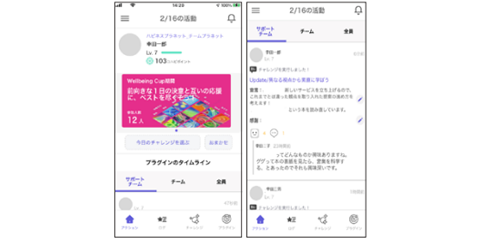Social Innovation Business
- Aiming for a Sustainable Society
- Hitachi’s Social Innovation Business
- Hitachi’s Social Innovation Business Cases
Aiming for a Sustainable Society
Approach & Policy
Hitachi has identified six material topics and 15 sub-material topics as important management issues and pursues sustainability management as the core of business strategy.
The Mid-term Management Plan 2024 focuses on business that emphasizes both environmental challenges and the wellbeing of each and every person. Based on this strategy, we strive to grow and expand our Social Innovation Business.
Hitachi’s Social Innovation Business
Approach & Policy
Hitachi aims to support people’s quality of life with data and technology that fosters a sustainable society, while respecting planetary boundaries and realizing wellbeing for all individuals. The key to achieving this goal is the growth of our Social Innovation Business, which is business that provides solutions for social and customer challenges through co-creation with various partners by leveraging IT x OT x Products and Lumada.
Hitachi’s Social Innovation Business Cases
Activities
Materiality
Advancing a Sustainable Energy Future for All
Hitachi Energy is a global technology leader that is advancing a sustainable energy future for all and supporting the worldwide efforts in reducing the impact of greenhouse gases. The elimination of SF6 from high-voltage electrical substation equipment is widely accepted as being an important step toward reaching carbon neutrality and enabling more sustainable grid operations. EconiQ™, Hitachi Energy’s eco-efficient portfolio for sustainability, accelerates the industry’s transition away from SF6 with products, services, and solutions, that are proven to deliver exceptional environmental performance.
Over the last two years, Hitachi Energy has made substantial progress in commercializing high-voltage EconiQ™ products that eliminate SF6 with scalable solutions for the lowest carbon footprint. Various high-voltage SF6-free EconiQ™ products have been installed across the globe, including 72.5 and 145-kilovolt (kV) Live Tank Breakers, 145 kV gas-insulated switchgear, and 420 kV gas-insulated lines.
An important milestone was the launch of the 420 kV SF6-free circuit breaker in 2022, a breakthrough technology that unlocks the widest range of eco-efficient switchgear applications and accelerates the energy transition. Another innovation, EconiQ™ retrofill, replaces SF6 in installed high-voltage gas-insulated lines with an eco-efficient gas mixture to improve the environmental and life cycle performance of the equipment. The commercialization of SF6-free alternatives is important as it unlocks new decarbonization pathways for transmission system operators. Hitachi Energy is reinforcing its commitment toward a carbon-neutral energy future through EconiQ™. Addressing the growing demand for eco-efficient solutions, Hitachi Energy will continue to expand the SF6-free portfolio across the entire high-voltage switchgear range, demonstrating the scalability of the portfolio and strengthening the company’s position as a sustainable technology leader within the industry.
EconiQ™ of Hitachi Energy

Co-creation on Advanced Technologies Leading Environmental and Social Value Creation
In Andorra, Hitachi Energy is working as a partner with the country's public electricity supplier, Forces Eléctriques d'Andorra (FEDA), to meet growing electricity demand while protecting the natural environment and people's livelihoods. Located inland in Europe with an area of 468km2, approximately 92% of Andorra’s land is covered in forest. The country therefore puts great effort into environmental conservation to mitigate the effects of climate change.
Hitachi Energy provides a new renewable energy solution that can guarantee the growth of the electricity supply while working on FEDA's La Gonarda substation to optimize the distribution of electricity between two valleys in the north of the country. Operations at this substation have been made possible through collaboration between companies that share a common vision and passion for a sustainable energy future. When building the substation, environmental impact study was conducted to check the impact on local residents, flora and fauna and to ensure the substation's efficiency. Measures are then taken to minimize the impact on the environment when building substations in woodland close to residential areas. During this process, Hitachi Energy was selected by FEDA as a partner capable of providing sustainable and environmentally friendly power equipment.
Specifically, Hitachi Energy provided Europe's first EconiQ™ transformer to FEDA. As well as its low carbon footprint, Hitachi Energy's 20/26 MVA, 106/21 kV three-phase power transformer also emits extremely low levels of noise, minimizing noise disturbance to local residents and wildlife.
It is also insulated and comes with optimal cooling technology to suppress vibration and electromagnetic interference beyond required standards. To further improve safety, the transformer was filled with high fire point fluid and inside a room with an isolating wall. Those supplementary characteristics not only help in reducing noise levels but also contribute to physically isolate the transformer to create extra containment levels in case of transformer failure.
The collaboration between FEDA and Hitachi Energy has improved operational efficiency and reduced the carbon footprint by approximately 15% compared to conventional designs. Hitachi Energy also provides a Life Cycle Assessment (LCA) report to enable FEDA to make decisions based on a thorough assessment of the transformer’s environmental performance and service life as an asset. A disposal manual is also provided to ensure that, when the time comes to dispose the transformer, materials are salvaged safely and with minimal impact on the environment.
This project, with co-creation at its heart, considers the lifecycle from raw material procurement to disposal at every stage of the order process to product evaluation. Hitachi Energy will continue to work towards achieving a decarbonized society through its business.
FEDA's La Gonarda substation equipped with a Hitachi Energy EconiQ™ transformer
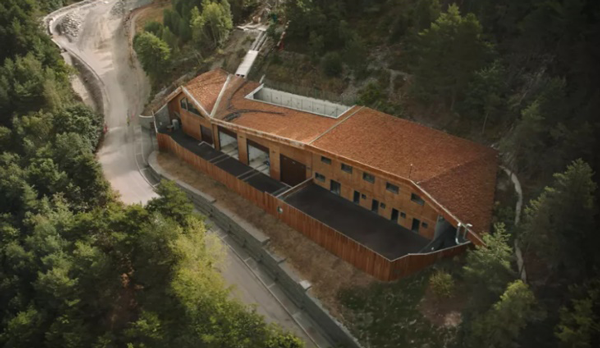
Hitachi Rail Develops Europe's First Tribrid Train
As the EU and European governments set goals to achieve net zero by 2050, decarbonization solutions are being sought for various transport. Due to cost of new infrastructures, there are thousands of tracks that are unlikely to be electrified in Europe. Electrification, construction and maintenance of overhead lines are costly and take time to deliver. As a result, the proportion of electrified railway lines across Europe remains below 60%.
To address such social challenges, Hitachi Rail has developed Europe's first tribrid train derived from Hitachi Rail’s Masaccio Platform and called “Blues” in collaborations with the customer. Blues is a train that runs off three different power sources that include electricity, batteries, and a diesel engine. On electrified routes, it uses pantographs to draw power from the overhead lines, but on non-electrified lines, it primarily operates using batteries. When the batteries are low on charge, it switches to the diesel engine. This flexibility enables the train to operate smoothly and seamlessly on both electrified and non-electrified sections, reducing CO2 emissions and saving fuel. Furthermore, by shutting off the engine when approaching, stopping at, and departing from stations, fuel consumption can be reduced by up to 50% compared to conventional diesel trains, with a significant reduction in noise as well.
Moreover, the Blues is equipped with the European Rail Traffic Management System (ERTMS), a single European signaling and speed control system that ensures operability across national railway systems. ERTMS monitors and controls train speed, acceleration, and braking systems to optimize energy consumption and reduce CO2 emissions, while automatically activating train safety features in an emergency.
Every feature and solution are designed to optimize energy consumption, such as the innovative air conditioning system that regulates its functioning based on real time number of passengers on board and the LED lighting system that contributes to save energy significantly.
Blues Train introduction not only addresses environmental concerns but revolutionizes the passenger experience thanks to its distinctive design improved by merging Italian and Japanese cutting-edge technologies and well-proof know-how in the industry. The four-car layout can host up to 300 passengers, reaching a maximum speed of 160 km/h, thereby enhancing performance and reducing journey times.
Blues Train embraces the most innovative solutions to improve passengers’ journey (e.g. passengers’ information screens, passengers counting technology, drinks and snacks dispenser area, bike areas and high luggage transport capacity, USB and 220V power sockets for greater connectivity) and ensures passengers safety controls thanks to closed-circuit television (CCTV) surveillance.
Hitachi Rail has delivered the Blues model to Italy's railway operator, Trenitalia. Trenitalia is on track to modernize its trains and transform regional railway systems with Blues trains now operating in eight regions across the country. Looking ahead, Hitachi Rail aims to leverage its advanced next-generation hybrid technology to support Europe’s train operators and their moves toward decarbonization, while offering secure, comfortable, and highly convenient transportation options.
Blues is Europe's first tribrid train developed by Hitachi Rail

Supporting High-capacity EV Charging at Major Commercial Truck Depot
Hitachi Energy is supporting US-based Penske in its efforts to deploy electric vehicles to its customers by providing the state-of-the-art Grid-eMotion® Fleet EV charging system. Grid-eMotion® Fleet is an integrated DC fast-charging grid-to-plug charging solution. Penske is rolling this out at a major commercial truck depot in Stockton, California, to support high-capacity charging for its electric vehicles.
In this groundbreaking project, Grid-eMotion® Fleet offers scalability and multi-megawatt high-power charging capacity tailored to meet the demanding requirements of truck fleets of varying sizes. System features include space savings of up to 60 percent compared to conventional charging systems, and reduced cabling needs by up to 40 percent, all while maintaining high-capacity charging performance.
Investing in electric vehicle and charging solutions enables customers to decarbonize their fleets and comply with emissions regulations. As such, building a robust public and private charging infrastructures is essential. Penske has been a pioneer in adopting battery electric commercial vehicles and has made substantial investments in testing, maintaining, and expanding charging infrastructure to support these vehicles. The company has been continually testing and operating EV trucks across its leasing, rental and logistics fleets in various industries including retail, manufacturing, grocery, quick-service restaurant chains, medical, and automotive parts.
Hitachi Energy’s Grid-eMotion® Fleet charging system in Stockton is already being used to charge a growing number of small, medium and heavy-duty trucks. Its 10 charging stations can simultaneously charge 10 trucks at a maximum of 100kW each, or five trucks at a maximum of 200 kW each, showcasing its versatility and scalability for Penske’s fleet operations.
Additionally, Hitachi and Penske are exploring AI-based smart charging solutions to optimize vehicle charging processes. This endeavor is expected to unlock fresh prospects in service, maintenance and electric vehicle charging throughout Penske’s fleet.
Penske’s EV charging station equipped with Hitachi Energy's charging solution, Grid-eMotion® Fleet
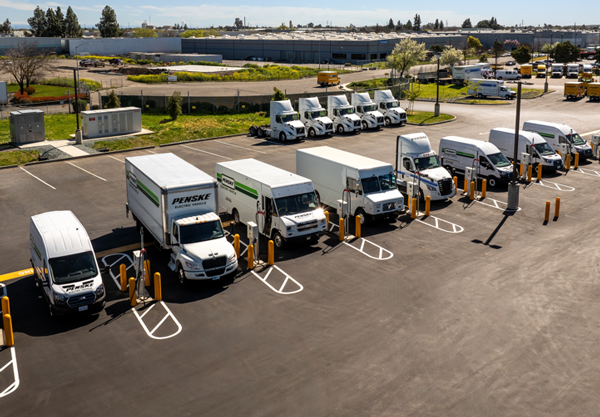
Consolidated Digital Backup to Boost Cybersecurity
Hitachi Vantara has developed a robust data protection and digital backup system for Germany's RWTH Aachen University, helping the university bolster its cybersecurity measures.
The German State of North Rhine-Westphalia (NRW) is a leading industrial region in Germany and home to 18.1 million people. NRW is focusing on strengthening the digital capabilities of its 42 public universities and higher education institutions to improve and streamline services across the higher education sector. As part of this innovation program, NRW has decided to consolidate digital infrastructure services, including data backup and recovery.
RWTH Aachen University, one of Germany’s Universities of Excellence and home to over 47,000 students, has been spearheading the drive to create a standardized backup and recovery service. Traditionally, the design and operation of data backup and recovery processes and solutions at universities in NRW varied by school, faculty, and research institute, with some more reliable than others. To boost productivity across universities, increase cost-efficiency and strengthen protection against cyberthreats such as ransomware, the state decided to fund a project to build a consolidated digital infrastructure service for all universities.
Working closely with Hitachi Vantara, RWTH deployed Hitachi Content Platform (HCP), a high-performance, scalable distributed object storage solution, across six data centers at RWTH Aachen. The system was built with six clusters, each with 12 nodes and a total capacity of 56 PB, to ensure that if one location fails due to a major disaster such as a power outage or fire, there will be no impact for users or mission-critical data.
The university also launched a large-scale IT service program called Datensicherung.NRW (NRW Data Backup), available to all universities in the state, with the HCP playing a crucial role in its operation. By utilizing NRW Data Backup, universities in the state of NRW can more easily and cost-efficiently minimize the risk of data loss.
RWTH Aachen University has deployed the Hitachi Content Platform (HCP) to its data centers
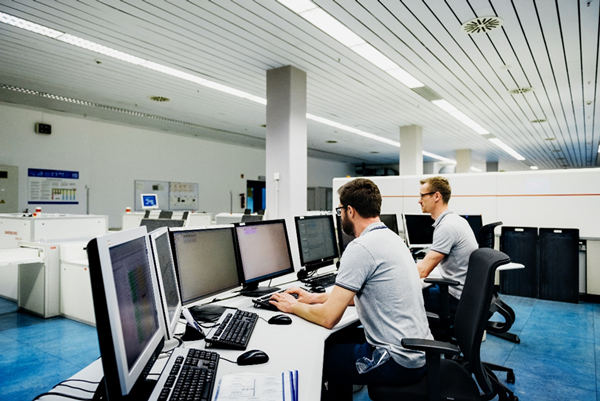

Initiatives to Develop Healthcare
Among numerous social issues, the increasing prevalence of serious illnesses such as cancer accompanying an aging population is becoming a significant challenge not only in Japan but also worldwide. Because of this, there are high hopes for development in the healthcare field. Through collaborative creation with medical and pharmaceutical professionals, Hitachi is contributing to the development of global healthcare, including early detection of diseases and less invasive treatments, by promoting the advancement and digitalization of diagnosis and treatment.
In the field of diagnostics, Hitachi primarily develops and provides measurement and analysis systems used in the biomedical and life science fields, supporting accurate and reliable in vitro diagnosis. In the field of clinical chemistry and immunological blood testing, in particular, Hitachi High-Tech analytical systems are used to conduct approximately 20 billion tests per year, supporting the advancement of diagnosis and therapy planning around the world. With regard to new in-vitro diagnostics, we have invested in U.S. company Invivoscribe, Inc., a global provider of testing services mainly for blood cancers, collaborating with them to advance molecular diagnostics. This collaboration will enable us to contribute to the early detection of cancer, therapy planning, and drug development by pharmaceutical companies, leading to healthier and safer societies. Additionally, we have begun developing a new genetic testing system in collaboration with Sysmex Corporation. This genetic testing system will be developed based on Hitachi High-Tech's capillary electrophoresis sequencer. Initially focusing on clinical implementation in the field of cancer, the aim is to gradually expand into other disease areas.
Hitachi High-Tech has opened the Healthcare Innovation Center Tokyo, an integrated laboratory near Tenkubashi Station in the Haneda area, which serves as a place for collaborative creation with customers and knowledge sharing. We will use the innovations created at the center to improve the quality of life for people all over the world.
Hitachi has been actively engaged in advancing radiation cancer therapy and regenerative medicine in therapeutics. Radiation therapy is a cancer treatment method that involves treating the affected area without the need for surgical removal, thereby putting the body under relatively less stress. In May 2023, Taiwan's first heavy ion therapy system commenced operations at Taipei Veterans General Hospital. Additionally, in July, the HKSH Medical Group, with the Hong Kong Sanatorium & Hospital under its umbrella, and in August, the National Cancer Centre Singapore, started operations of proton therapy systems, reflecting the growing use of radiation therapy systems around the world. To date, more than 100,000 patients have been treated with Hitachi's system (as of December 2023).
In addition, by leveraging our expertise accumulated in radiation therapy systems, we have developed a new X-ray therapy equipment, the OXRAY linear accelerator, taking it to market in July 2023. Hitachi will contribute to the further development of cancer treatment by providing minimally invasive, cost-effective radiotherapy systems that are tailored to each patient, helping to create a society without fear of cancer.
In regenerative medicine and cell therapy, we are conducting joint research with Kyoto University and Rebirthel Co., Ltd. to promote the use of allogeneic T-cell therapy, an effective treatment for cancer. The widespread use of allogeneic T-cell therapy, which is more versatile and allows for the treatment of larger numbers of patients, will require the development of automated cell culture technology that supplies large quantities of cells with consistent quality. Hitachi will contribute to the practical application of this technology through this joint research.
We have also begun joint research with Mass General Brigham (MGB) of Harvard Medical School, the world-renowned medical research institution in the United States, in the field of gene and cell therapy to overcome intractable diseases. Hitachi will leverage its diverse technology portfolio, including its automated cell culture and digital technologies, to contribute to the practical application of the new therapy pioneered by MGB.
In April 2024, Hitachi integrated some if its businesses, including its radiation therapy system and automated cell culture system for regenerative medicine, into Hitachi High-Tech. By further integrating digital technologies into diagnosis and treatment, we aim to create healthcare innovations, from high-quality, high-function diagnostics and minimally invasive treatments, to optimal diagnosis and treatment, and personalized medicine.
Healthcare Innovation Center Tokyo
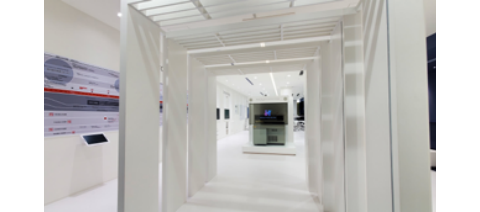
The OXRAY linear accelerator
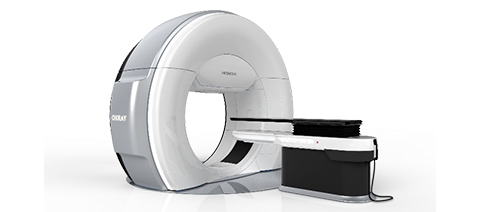
Creating a Happy Workplace
The change from the mass production and consumption society of the 20th century to a 21st century society that values the environment and diversity is rapidly occurring. So there is a growing movement to review companies, work styles, and communities from the perspective of happiness or, in other words, wellbeing.
Hitachi established Happiness Planet, Ltd. in 2020 to develop software applications and services that use data to enable people and groups to be happy and productive. By analyzing large amounts of data, we discovered that people in happy and productive groups are more likely to have triangular-shaped connections, whereas those in unhappy groups have V-shaped ones. The Happiness Planet application helps to create such triangular connections, i.e. Factor X for happy and productive people.
Since organizations tend to have V-shaped or vertical relationships with people, we use digital technology to help establish the triangular relationships that lead to the creation of happy and productive groups. Facilitated by smartphone or PC apps, people are put into groups of three each week in order to create triangular connections and interactions that lead to mutual understanding.
By fiscal 2023, Happiness Planet have provided services to 200 companies and over 40,000 users. This creation of triangular relationships was facilitated in a wide range of organizations in various sectors, from large corporations to small- and medium-sized enterprises, in areas ranging from IT, manufacturing, finance, healthcare, and nursing. All Nippon Airways Co., Ltd. (ANA) held a team competition event called the ANA Group Happiness Cup using the Happiness Planet app to give employees a better sense of connection between each other and help stimulate communication. The Hitachi Group used this app to create triangular relationships between new employees. Use of the app strengthened peer relationships, increased employee motivation, and improved performance in examinations for IT certifications. Working with various partners to leverage our strengths in IT, OT, and products, Hitachi will continue to pursue initiatives to create happy workplaces, happy lives, and wellbeing in society.
Triangular Relationships Essential for Wellbeing in an Organization
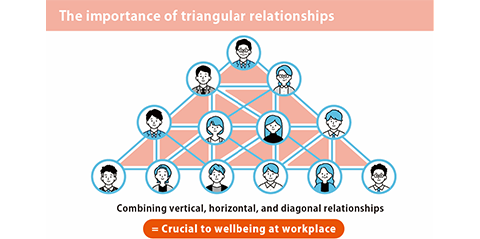
Smartphone App Screenshot
